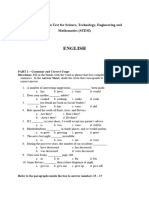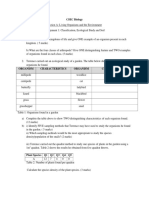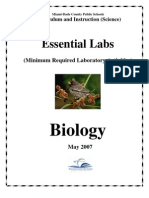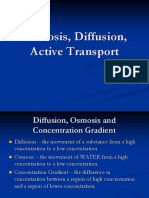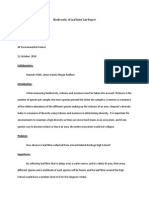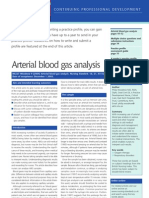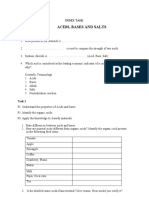Water Quality Worksheet
Water Quality Worksheet
Uploaded by
MheyMartinezCopyright:
Available Formats
Water Quality Worksheet
Water Quality Worksheet
Uploaded by
MheyMartinezOriginal Description:
Copyright
Available Formats
Share this document
Did you find this document useful?
Is this content inappropriate?
Copyright:
Available Formats
Water Quality Worksheet
Water Quality Worksheet
Uploaded by
MheyMartinezCopyright:
Available Formats
Name: _______________________________
Date: _____________________ Core: _____
Water Quality
For aquatic organisms, both plants and animals, a sudden or drastic change in their environment can be life-
threatening, so testing the quality of water in terms of temperature, pH, oxygen levels, and nitrates is
essential in determining the overall health of a water source. Monthly monitoring and frequent observations
are necessary in order to sustain hearty ecosystems and make sure pollution is not becoming a problem or
excess nutrients are not disrupting the balance. Described below are some water quality factors that can
easily be assessed to find out how a water system is doing.
Temperature
There are many factors that can affect water temperature causing it to increase or decrease. Shallow water
tends to be the temperature of its surroundings…warm if in a sunny area, cooler if shaded. Thermal
pollution (the release of hot water from factories) and run-off from hot asphalt can increase water
temperatures dramatically. Water temperatures outside the “normal” range can be harmful to aquatic plants
and animals by lowering their resistance to pollutants, diseases, and parasites.
Many aquatic organisms prefer cooler water than warmer water. Cooler water is more dense, so it is found in
deeper waters. Warmer water is less dense, so it is found closer to the surface. Why do organisms prefer the
cooler waters? The temperature of the water plays a key role in the amount of dissolved gases like oxygen or
carbon dioxide. As water gets colder, more oxygen can be dissolved in it. Organisms that require more
oxygen will be found in deeper parts of the water because it is plentiful down there. Aquatic plants behave a
little differently and like to float on top of or be close to the surface of the water. Warmer water and
exposure to sunlight will increase the amount of photosynthesis aquatic plants and algae perform.
Unfortunately, too much photosynthesis will lead to excessive plant growth and algal blooms.
Directions: Based on what you read…identify the effects from the causes of increasing and decreasing
temperatures.
Possible Causes Possible Effects
Increasing Shallow water
Temps Warmer air temperature
Direct sunlight
Thermal pollution
Warm run-off
Decreasing Deep water
Temps Cooler air temperature
Shady
Name: _______________________________
Date: _____________________ Core: _____
Dissolved Oxygen (DO)
As you well know by now, oxygen is a necessity for respiration, and respiration is a life process of all living
things. So, how does oxygen get into the water in order to be used by aquatic organisms for their survival?
Oxygen gas dissolves in water in a variety of ways. Some oxygen will naturally diffuse into the water
directly from the air. Photosynthesis by aquatic plants, algae and phytoplankton will contribute large
amounts of oxygen. Of course they do this by removing the carbon dioxide produced primarily by aquatic
animals…part of a cycle called the O2/CO2 cycle.
Dissolved oxygen will also change as a result of an algal bloom. While the algae are growing at a fast rate,
the DO levels will increase. As the resources get used up, space, light, and CO2 become limited, the algae
will start to die off. As a result, bacteria will begin to rapidly decompose the dying/dead algae, a process
requiring lots of oxygen. Thus the before mentioned abundance of DO, suddenly becomes depleted. This
phenomenon is known as eutrophication and is usually caused by an excess of nutrients from fertilizer run-
off to begin with. DO levels can become so low after this that many other aquatic organisms begin to die off
as well because they don’t have enough oxygen for survival. Ultimately, oxygen gas is vital to the existence
of most aquatic organisms and contributes to a greater diversity of living things when abundant and plentiful.
Directions: Based on what you read…identify the effects from the causes of increasing and decreasing
oxygen levels.
Possible Causes Possible Effects
Increasing Cooler water
DO Photosynthesis is
occurring
Algal bloom (initial)
Decreasing Warmer water
DO Night time (no
photosynthesis)
Excess decomposition
Name: _______________________________
Date: _____________________ Core: _____
pH
When water mixes with certain substances, the bonds between the oxygen and hydrogen atoms can be broken
into hydrogen (H+) or a hydroxide (OH-) ions. When this happens, water can become more alkaline (basic)
or acidic. The concentration of hydrogen or hydroxide ions determines water’s pH value and is assessed
using a scale of 1—14. When the concentration of these two ions is equal, water has a pH of 7…what we
call neutral. More H+ ions decrease the pH, making the water more acidic. More OH- ions increase the pH,
making the water more alkaline or basic.
The pH of water may be affected by rainfall, which is slightly acidic because it carries with it dissolved
carbon dioxide (carbonic acid) and other pollutants. However, run-off that travels over certain minerals such
as limestone on its way to a stream or river can cause the pH to become more alkaline. Other things that can
affect pH are photosynthesis (uses up CO2), decomposition (creates CO2), respiration (creates CO2) and
excretion (creates ammonia). As you can see in the graphic above, aquatic organisms can be greatly affected
by sudden changes in the water’s pH.
Directions: Based on what you read…identify the causes of increasing and decreasing pH levels.
Possible Causes Possible Effects
Increasing Plants will not grow
pH Harmful or lethal to fish if too basic
(alkaline)
Decreasing Fish eggs will not hatch
pH Harmful or lethal to fish, frogs, and insects
(acidic) if too acidic
Name: _______________________________
Date: _____________________ Core: _____
Nitrates and Nitrites
Nitrogen is a necessity of life used to build proteins. Even though most of the air in the atmosphere is made
up of nitrogen gas, plants and animals have no way to use it or convert it into the usable form of
nitrogen…nitrites and nitrates. Fortunately, bacteria, through decomposition of waste and dead or decaying
matter, “fix” the nitrogen for other living things through a process called the nitrogen cycle.
Waste
*Nitrosomonas and Nitrospira are types of bacteria
Certain bacteria in the water and gravel change nitrogen in the ammonia of waste products into nitrites and
nitrates. Plants diffuse nitrates into their roots/leaves so they can be used by the plants to build proteins.
Then animals will eat plants to get their needed nitrogen for protein production. Animals create waste and/or
organisms die which will be decomposed and the cycle starts all over. This of course is grossly simplified,
but it highlights the basic principles of the nitrogen cycle.
One other way nitrates enter an aquatic environment is from agricultural run-off containing fertilizers or
excess nutrients. Nitrates are relatively harmless to freshwater fish, but they will also act as a fertilizer for
plant growth. An excess of nitrates will allow more photosynthesis to take place in plants and algae, thus
leading to eutrophication. Algae will blanket the entire surface of the water and the plants that grow
underneath the water will not get enough light and die. Decomposition ensues and all the oxygen is used up
causing other organisms to die too. So, although the nitrates themselves are harmless, their presence can
have devastating effects.
Reflection: Answer the following questions in complete sentences and use information from above to
support your answer.
1) Suppose the nitrate level rose significantly for several weeks. How would the plants and animals be
affected? How might water quality change?
2) Sally was very excited about her new fish tank. In one evening, she filled it with water, treated the water
to remove harsh chemicals, added a couple plants and several fish. Within 2 weeks, everything in her tank
died. Based on what you read above…what might be the cause of Sally’s tank of death?
You might also like
- 4.2 Energy FlowDocument5 pages4.2 Energy FlowJason CharlesNo ratings yet
- Active Reading: Answer KeyDocument3 pagesActive Reading: Answer KeyJonas Montero100% (2)
- SBI4U Unit 5 Practice TestDocument6 pagesSBI4U Unit 5 Practice TestAreebaNo ratings yet
- Postlab Questions For Chromatography LabDocument1 pagePostlab Questions For Chromatography Labapi-296720528No ratings yet
- Lorax Truax QuestionsDocument2 pagesLorax Truax Questionsapi-264150929No ratings yet
- Transfer of EnergyDocument30 pagesTransfer of EnergyRizza Benico MabagosNo ratings yet
- Dyi Dichotomous Key Guided Inquiry PaperworkDocument7 pagesDyi Dichotomous Key Guided Inquiry Paperworkapi-250608665No ratings yet
- Cell Biology Worksheet Blank4Document10 pagesCell Biology Worksheet Blank4Loveena SteadmanNo ratings yet
- Science 7 Unit Plan Interactions and EcosystemsDocument20 pagesScience 7 Unit Plan Interactions and Ecosystemsapi-266874931No ratings yet
- Methods of Studying MangrovesDocument10 pagesMethods of Studying MangroveshanggarPKNo ratings yet
- Deforestation WorksheetDocument4 pagesDeforestation Worksheetapi-2398696790% (1)
- 6th Grade Ecosystem VocabularyDocument2 pages6th Grade Ecosystem Vocabularyapi-262495543No ratings yet
- Interpreting Carrying Capacity Graphs PDFDocument5 pagesInterpreting Carrying Capacity Graphs PDFMingNo ratings yet
- Ste TestDocument27 pagesSte TestMARK GENICK BALINTECNo ratings yet
- Can You Spot The Scientific MethodDocument1 pageCan You Spot The Scientific MethodMelvin CabonegroNo ratings yet
- Category 5-Bonus PacketDocument11 pagesCategory 5-Bonus Packetapi-312542882No ratings yet
- Osmosis Lab - Part I: Name/Hour - Group #Document5 pagesOsmosis Lab - Part I: Name/Hour - Group #RondatheDMNo ratings yet
- Assignment 1 Classification, Ecology and SoilDocument2 pagesAssignment 1 Classification, Ecology and SoilLee-Anne LutchmanNo ratings yet
- A Course Outline Ecology 2014 2015Document11 pagesA Course Outline Ecology 2014 2015Jamila BestNo ratings yet
- Water WorksheetDocument2 pagesWater WorksheetJohn OsborneNo ratings yet
- EcologyDocument92 pagesEcologyapi-272720493No ratings yet
- Biology RelDocument72 pagesBiology RelkajfkjljakjNo ratings yet
- Lesson Plan 1-Working Like A ScientistDocument9 pagesLesson Plan 1-Working Like A ScientistAmaziah GedaliahNo ratings yet
- Bonding Basics 2010Document9 pagesBonding Basics 2010AneilRandyRamdialNo ratings yet
- SCI - Learning Packet - Biology Week 5Document13 pagesSCI - Learning Packet - Biology Week 5Pal, Julia HanneNo ratings yet
- Photosynthesis PDDocument3 pagesPhotosynthesis PDMorgan MatthewsNo ratings yet
- CSEC Biology June 2013 P032Document10 pagesCSEC Biology June 2013 P032Terence JamesNo ratings yet
- Biology Lab ManualDocument32 pagesBiology Lab ManualDũng Nguyễn100% (1)
- Cell Parts Practice QuizDocument3 pagesCell Parts Practice QuizAnonymous yFS1ZfmBpNo ratings yet
- Biology Lab Report 10 (Ecology)Document22 pagesBiology Lab Report 10 (Ecology)Muhamad Aleiff Bin Tajuddin100% (1)
- Integrated Science Grade 10 Weeks 1-5 - Term 3Document52 pagesIntegrated Science Grade 10 Weeks 1-5 - Term 3Daniel DowdingNo ratings yet
- Food ChainDocument1 pageFood ChainSidjay PaulinoNo ratings yet
- Conserving Biodiversity (5.3) : State StandardDocument33 pagesConserving Biodiversity (5.3) : State Standardayu711100% (1)
- Catalase Lab ActivityDocument6 pagesCatalase Lab Activitysenja fitrianaNo ratings yet
- L5 BiodiversityDocument32 pagesL5 Biodiversitytevin_prawlNo ratings yet
- Heart Dissection - Grade 9 (Sy 2022 - 2023)Document2 pagesHeart Dissection - Grade 9 (Sy 2022 - 2023)danielNo ratings yet
- Osmosis, Diffusion, Active TransportDocument21 pagesOsmosis, Diffusion, Active TransportPrince SanjiNo ratings yet
- Acid Base LabDocument2 pagesAcid Base LabMichael StillNo ratings yet
- Sci 6 Suspensions and ColloidsDocument29 pagesSci 6 Suspensions and ColloidsDionelyn CruzNo ratings yet
- Grade 8 - Integrated Science Consolidated CurriculumDocument12 pagesGrade 8 - Integrated Science Consolidated Curriculumshonaishot hottieNo ratings yet
- Science Cat 1Document8 pagesScience Cat 1SamrongNo ratings yet
- Logistic VsDocument5 pagesLogistic Vsapi-242868690No ratings yet
- Classification ActivityDocument4 pagesClassification Activityerin killeenNo ratings yet
- Classification of Organisms-VMDocument67 pagesClassification of Organisms-VMLee-Anne Lutchman100% (2)
- D0709558 M06 CH01 L01 Lesson QuizDocument1 pageD0709558 M06 CH01 L01 Lesson QuiznidhiNo ratings yet
- IGCSE - Bio - Lesson Plan 14 - EcosystemsDocument4 pagesIGCSE - Bio - Lesson Plan 14 - EcosystemsKim GuermacheNo ratings yet
- ECOLOGY-1 (Compatibility Mode)Document6 pagesECOLOGY-1 (Compatibility Mode)Tony Sdj100% (1)
- Introduction To ClassificationDocument2 pagesIntroduction To Classificationapi-395791665No ratings yet
- 10 3 Tropic Response ppt2Document37 pages10 3 Tropic Response ppt2api-309893409No ratings yet
- Photosynthesis Activity Sheet Group6Document5 pagesPhotosynthesis Activity Sheet Group6Angelica TejadaNo ratings yet
- AP Biology Primary Productivity Lab ReportDocument9 pagesAP Biology Primary Productivity Lab ReportVictor Martin100% (1)
- Leaf Litter Lab ReportDocument6 pagesLeaf Litter Lab Reportapi-2676017820% (1)
- Lesson Plan On Food WebDocument9 pagesLesson Plan On Food Webapi-325089664No ratings yet
- 5.1 Microscope Skills ActivityDocument6 pages5.1 Microscope Skills ActivityDean JezerNo ratings yet
- Form Iv Csec Biology Carbon CycleDocument2 pagesForm Iv Csec Biology Carbon CyclesuggaballNo ratings yet
- Limiting Factors of PhotosynthesisDocument3 pagesLimiting Factors of Photosynthesisron971No ratings yet
- Assignment 2 - Data LoggingDocument11 pagesAssignment 2 - Data LoggingNur ShahidaNo ratings yet
- Water Quality Analysis by Scientific MethodDocument5 pagesWater Quality Analysis by Scientific Methodpuneet kumarNo ratings yet
- Water Quality Online-Summer Maria ArriagaDocument6 pagesWater Quality Online-Summer Maria ArriagaM ArNo ratings yet
- What Is Water Pollution?: Health Effects of MicrorganismsDocument3 pagesWhat Is Water Pollution?: Health Effects of MicrorganismsVel MuruganNo ratings yet
- Water Quality ParameterDocument4 pagesWater Quality ParametercallantagNo ratings yet
- Carbon Dioxide in AtmDocument11 pagesCarbon Dioxide in AtmMheyMartinezNo ratings yet
- Air QualityIndex LessonDocument26 pagesAir QualityIndex LessonMheyMartinezNo ratings yet
- ResourcesDocument9 pagesResourcesMheyMartinezNo ratings yet
- RelationshipDocument14 pagesRelationshipMheyMartinezNo ratings yet
- Developing Effective Study HabitsDocument25 pagesDeveloping Effective Study HabitsMheyMartinezNo ratings yet
- Space ExplorationDocument7 pagesSpace ExplorationMheyMartinezNo ratings yet
- Cloze Cycles in NatureDocument3 pagesCloze Cycles in NatureMheyMartinezNo ratings yet
- PH Meter Denver Ub10Document24 pagesPH Meter Denver Ub10Pani ApostolidisNo ratings yet
- Arterial Blood Gas AnalysisDocument8 pagesArterial Blood Gas AnalysisMichael NapoleonNo ratings yet
- E595 PDFDocument8 pagesE595 PDFPruthwiraj BokadeNo ratings yet
- Acid Base Equilibria PDFDocument30 pagesAcid Base Equilibria PDFLin Xian XingNo ratings yet
- WET Operator Essentials - Anaerobic Digestion - Dec - 12Document2 pagesWET Operator Essentials - Anaerobic Digestion - Dec - 12Serkan YukselNo ratings yet
- Acids and Bases 2Document35 pagesAcids and Bases 24D-31 WONG YUEN TSZNo ratings yet
- BS en 50483 6 2009Document27 pagesBS en 50483 6 2009Shara LogisticNo ratings yet
- rx01045 PDFDocument14 pagesrx01045 PDFyinglvNo ratings yet
- K Tsta 100a - DataDocument24 pagesK Tsta 100a - DataAyrtonNo ratings yet
- PH Iso & AatccDocument8 pagesPH Iso & AatccrasheudlNo ratings yet
- DocumentDocument3 pagesDocumenthaiburutikeswarNo ratings yet
- Sop PH Meter.Document4 pagesSop PH Meter.Brian HawkinsNo ratings yet
- c1Document23 pagesc1akashNo ratings yet
- Acids and Bases in Everyday LifeDocument6 pagesAcids and Bases in Everyday LifeLothar GraudinsNo ratings yet
- Acid and BaseDocument15 pagesAcid and BaseVillamor Baculi100% (1)
- Estimation of MG ManualDocument3 pagesEstimation of MG ManualAnsippNo ratings yet
- Acid Base and Salts - Index-Notes FinalDocument5 pagesAcid Base and Salts - Index-Notes FinalYatish BalamuruganNo ratings yet
- General Chemistry: Chapter 18: Additional Aspects of Acid-Base EquilibriaDocument20 pagesGeneral Chemistry: Chapter 18: Additional Aspects of Acid-Base EquilibrialotusputihNo ratings yet
- CHEM VivaDocument36 pagesCHEM Vivaalysonmicheaala63% (8)
- Reserve Alkalinity of Engine Coolants and Antirusts: Standard Test Method ForDocument4 pagesReserve Alkalinity of Engine Coolants and Antirusts: Standard Test Method Forcarmen martinezNo ratings yet
- The Solution For All Turbidimetric and Color-Indicated Titrations DP5 PhototrodeDocument2 pagesThe Solution For All Turbidimetric and Color-Indicated Titrations DP5 PhototrodeyudzakuNo ratings yet
- Cultura de Kombucha - Acid or AlkalineDocument3 pagesCultura de Kombucha - Acid or AlkalineMariana DinuNo ratings yet
- STPM 962/2: (40 Marks) Answer All QuestionsDocument7 pagesSTPM 962/2: (40 Marks) Answer All QuestionsLim Tze ChuenNo ratings yet
- Skema Chemistry Paper 3Document8 pagesSkema Chemistry Paper 3nurul atiqahNo ratings yet
- Anatomy and Physiology QnADocument229 pagesAnatomy and Physiology QnAMichael Khaii MagzNo ratings yet
- Users Manual Elyte-1Document68 pagesUsers Manual Elyte-1tamiratNo ratings yet
- LUFENURONDocument66 pagesLUFENURONElvia AngieNo ratings yet
- المنتجات المعقمةDocument238 pagesالمنتجات المعقمةnajwaelbarasiNo ratings yet
- Unit 5 - Buffer Solutins - Subjects 0Document67 pagesUnit 5 - Buffer Solutins - Subjects 0joshua andreNo ratings yet













